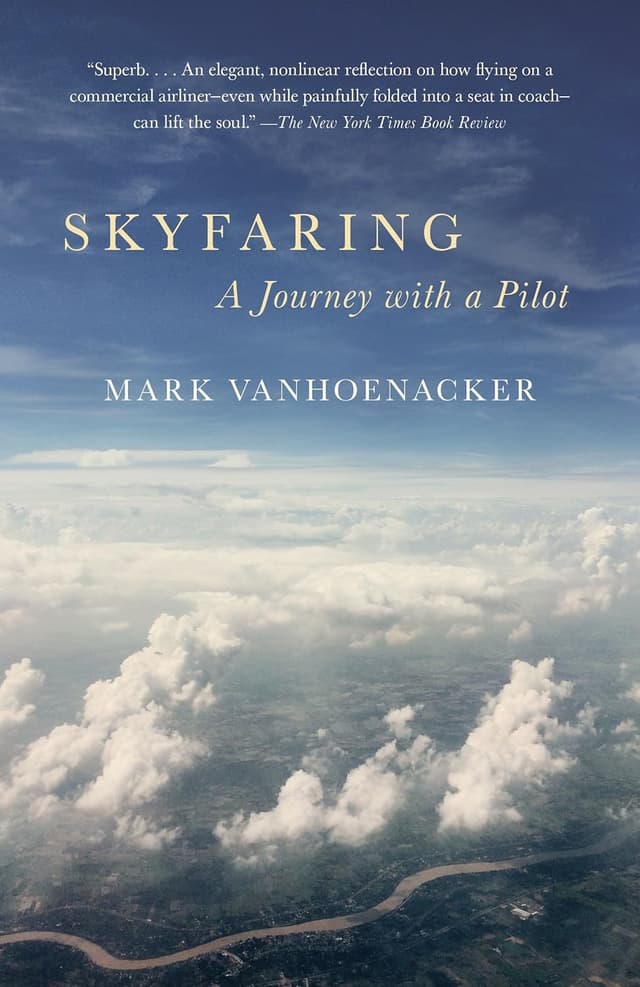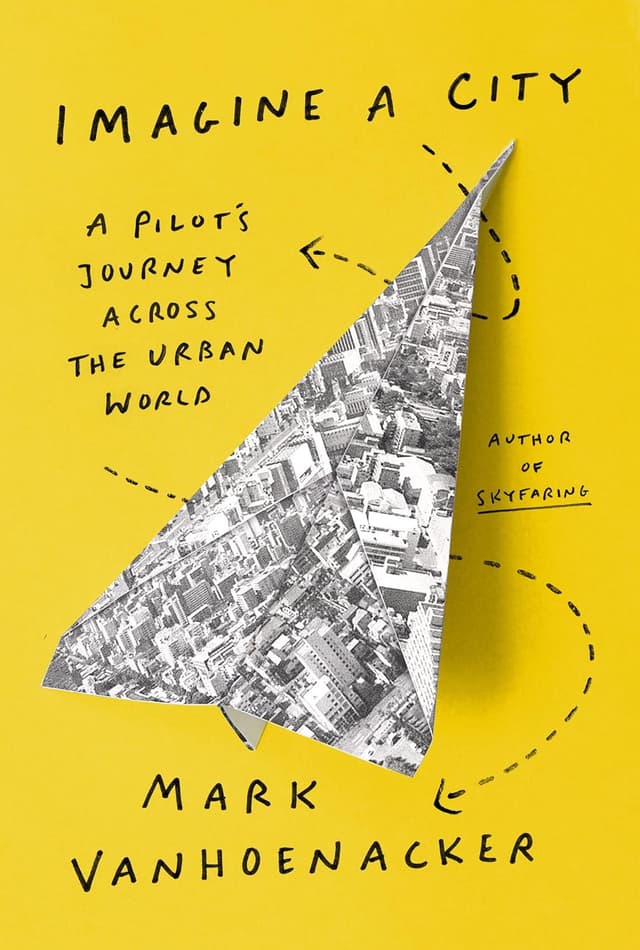Mark Vanhoenacker | July 10, 2023
The Monday Media Diet with Mark Vanhoenacker
On the Dreamliner, the experience of cities, and Japan
Recommended Products

Mark Vanhoenacker's first book, described by the New York Times as 'a superb chronicle'.

Mark Vanhoenacker's most recent book, called 'a love song to cities the world over' by the Wall Street Journal.
Mark Vanhoenacker (MV) is a London-based commercial airline pilot and a writer. His first book was the 2015 international bestseller Skyfaring, described by the New York Times as “a superb chronicle”. His most recent book is Imagine a City, which the Wall Street Journal called “a love song to cities the world over”. Find Mark on Twitter and Instagram, where he’s always happy to see your photos from the window seat.
Tell us about yourself.
I’m an airline pilot—I fly the Boeing 787 Dreamliner for British Airways—and a writer. I’m a columnist for the Financial Times and a regular contributor to the New York Times. In my first book, Skyfaring, I shared what it’s like to be a pilot. In my latest book, Imagine a City, I write about what it’s like to visit some of the world’s largest and most beloved cities again and again. In our urbanizing age, long haul pilots have an experience of cities that’s like no other in history.
I grew up in Pittsfield, a small city in the Berkshires region of western Massachusetts. In fact, my hometown serves as a touchstone in the new book, which is both a travelogue and a memoir. I found that recalling my small first city helped me reflect on my childhood dreams of becoming a pilot, as well as on the ways in which each of our lives—but especially, perhaps, a pilot’s life—may be imagined in geographical terms.
Describe your media diet.
On writing days, I set strict limits on my media consumption. I’ll start writing at 7am or so and go until a late lunch at around 2pm. I won’t check any news until then. Of course, it’s hard to avoid the news when I’m using a laptop to research and write. One trick that helps: my homepage is set to generate a random Wikipedia page. The page is often quite interesting and, more importantly, it keeps me from inadvertently plunging into the news cycle.
When I do turn to the news, I start with the two places I write for most often, the New York Times and the Financial Times. I love the Economist. For fascinating stories that don’t involve the news, I turn to Aeon, ever since I wrote an article for them about the language of flying. No surprise that I check in on a number of travel and aviation websites, including Skift, especially its Airline News page. I also read the Berkshire Eagle, my hometown newspaper, which—from hotel rooms and cafes all around the world—keeps me in touch with the place I was once so keen to leave.
On flying days, I tend to read the news on the bus and train that get me to Heathrow. I also listen to a lot of podcasts when I’m on the move: Slate’s Political Gabfest keeps me up to date on the U.S. political scene and I also love the deep but short dives into eclectic topics on the BBC’s In Our Time. Of course, once I check in for work at Heathrow, I get a refreshing break from all media. Many of my friends who work in the business world and travel frequently are also fans of ‘airplane mode’ and associate it with hours of enhanced productivity.
What’s the last great book you read?
I’ll read anything about Japan. I completed a homestay there in high school, then returned in college and in my business-world job. Now I’m a pilot who flies regularly to Tokyo. I recently read A Diplomat in Japan, in which Ernest Mason Satow relates his experiences in mid- to late-nineteenth century Japan, an era of pivotal importance to the country’s modern history.
What are you reading now?
I’m nearly finished re-reading Isak Dinesen: The Life of a Storyteller, Judith Thurman’s highly praised biography of a writer whose descriptions of flight are among the loveliest I know. Those aviation-themed passages appear in Dinesen’s Out of Africa, but in fact it’s her short stories that I return to most often. They reach us as if from a fantastical, pre-modern Europe—one that even in Dinesen’s time had already passed into myth. As a pilot I’ve had a chance to visit Dinesen’s two former homes—in Rungstedlund, north of Copenhagen, and Nairobi. I was struck to learn from Thurman’s book that when Hemingway won the Nobel Prize in 1954, he suggested that it should have gone to Dinesen instead.
When I was researching Imagine a City, I read a ton of nonfiction books about cities. If any of your readers have a favorite book about a favorite metropolis, drop me a note via my website or Twitter.
What’s your reading strategy when you pick up a print copy of your favorite publication?
A what copy?
Seriously, though, as a pilot it’s so much easier to do my reading online. One magazine I still receive in paper form, however, is Science News, which offers a slim digest of the latest developments across the scientific world—animals, medicine, particle physics, the distant cosmos, you name it. The writing is pitched to non-scientists and is a model of clarity. Science News is the magazine I can most easily picture my dad reading. I’m happy to carry the magazine to cafes in distant cities, where each issue is a reminder of my dad and his bottomless fascination with all the new things our species is learning.
Who should everyone be reading that they’re not?
Many Americans were forced to read portions of Moby-Dick in school, found it very hard going, and have never returned to it. I can sympathize—growing up in Pittsfield, Massachusetts, where Melville wrote his epic, I had to read more Melville than any kid should. Nevertheless, Moby-Dick, is worth a second (or first) look. I’m partial, of course, to globe-spanning journeys. And the complexity of the book’s structure (and even of its heavy, unwieldy sentences) are a rewarding challenge for those of us whose literary attention spans have been shortened by online media.
On that maritime note—I’m so enamored with aviation’s ties to the nautical realm that some years I read more about sailing than flying—I’d like to recommend three more nautical books. Reading the Glass is a new book about life at sea by Elliot Rappaport, a captain of traditional sailing vessels. The Sea and Civilization by Lincoln Paine is a glorious chronicle of how seafaring has shaped history. Finally, as I’m a regular visitor to Kuwait, Bahrain, Dubai and other glittering Gulf metropolises, I’d recommend Sons of Sindbad, in which Alan Villiers documents life on a dhow in the Gulf and along the East African coast in the 1930s, when the traditional livelihoods he encountered were about to be altered forever.
What is the best non-famous app you love on your phone?
No question here—it’s Kiwix, which allows you to store all of Wikipedia’s text and quite a lot of images on your smartphone. It’s a great way to learn about things when you’re traveling, especially if you’re abroad and don’t have data (or if you’re on a metro system without a signal). I also like Pimsleur’s language app, which I use for learning Japanese. Pimsleur lessons are designed around the particular intricacies of the language, which isn’t the case for many language apps.
Plane or train?
No guesses for how a pilot might answer. Nevertheless, I do love trains—indeed, my Twitter bio describes me as ‘fan of anything with windows and seats’. I recently wrote an article for the New York Times about London’s revolutionary Elizabeth line. And Tokyo’s incredible Yamanote line, which runs in a circle and connects many of the capital’s best-known districts, plays an important role in the last chapter of Imagine a City. To planes and trains I would also add commuter ferries. They’re a great way to get to know cities, so many of which, of course, have risen alongside rivers or natural harbors.
What is one place everyone should visit?
I’ll double down on Japan. To me, it’s the most reliably fascinating place in the world. I fly to Tokyo Haneda at least every other month. Tokyo is a great place to start your explorations of Japan. After you’ve been dizzied and dazzled by the largest city to have ever existed, head to the mountains or to Kanazawa, the west coast castle city where I spent a summer in high school. It’s easily reached by bullet train.
I’ll also recommend Pittsfield, my hometown in the beloved Berkshires region of western Massachusetts. (If you’ve got a flight to Logan coming up, it’s an easy two hour car ride west from Boston, and there’s also a new train service from New York’s Penn Station.) Pittsfield is blessed with history, in particular for fans of two great American institutions: baseball and, of course, Herman Melville, whose farmhouse is open to visitors. Pittsfield’s downtown is experiencing a renaissance, with bustling cafes and new restaurants. And you don’t need to leave town to enjoy the great outdoors. The city has several wildlife preserves as well as its own ski area, where night skiing was invented in the 1936.
Tell us the story of a rabbit hole you fell deep into.
In 2009 or so a friend introduced me to sourdough bread. I read up on it and decided to grow my own sourdough starter. Sourdough is meant to have a terroir much like wine, and so I suppose mine was the taste of north London.
This was also around the time I first joined Facebook, so I christened my starter ‘Sour Stan’ and got him his own Facebook account. Sour posted updates on his diet—flour—and occasional offered up wisdom in the form of bread-themed quotes and proverbs. My friends would sometimes engage online more with Sour than with me. I baked bread every day for months. Eventually we moved house and Sour expired, but I still get e-mails from Facebook reminding me that Sour’s friends haven’t heard from him in a while. Maybe I should do one of those memorial pages for him.
Aside from the jokes, and all the tasty bread that I broke with my friends and family, I’m grateful to Sour for another reason: one of the first articles I ever wrote was about Sour and how ancient traditions might intersect with the modern online world. A newspaper editor in London—I’d written to her at random—liked the article, published it, and encouraged me to keep writing. (MV)
